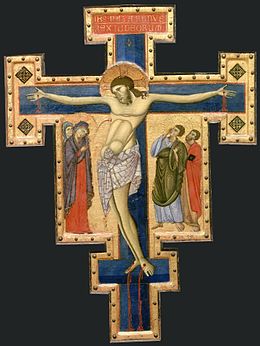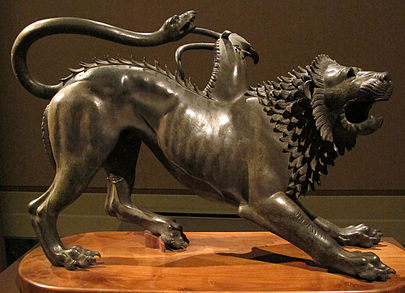The bronze “Chimera of Arezzo” is one of the best known examples of the art of the Etruscans. It was found in Arezzo, an ancient Etruscan and Roman city in Tuscany, in 1553 and was quickly claimed for the collection of the MediciGrand Duke of TuscanyCosimo I, who placed it publicly in the Palazzo Vecchio, and placed the smaller bronzes from the trove in his own studiolo at Palazzo Pitti, where “the Duke took great pleasure in cleaning them by himself, with some goldsmith’s tools,” Benvenuto Cellini reported in his autobiography. Court intellectuals of the time considered the Chimera of Arezzo to be a symbol of the Medici domination of the grand duchy.The Chimera is still conserved in Florence, now in the Archaeological Museum. It is approximately 80 cm in height.[1]
In Greek mythology the monstrous Chimera ravaged its homeland, Lycia, until it was slain by Bellerophon. The goat head of the Chimera has a wound inflicted by this Greek hero. Based on the cowering, representation of fear, and the wound inflicted, this sculpture may have been part of a set that would have included a bronze sculpture of Bellerophon. This bronze was at first identified as a lion by its discoverers in Arezzo, for its tail, which would have taken the form of a serpent, is missing. It was soon recognized as representing the chimera of myth and in fact, among smaller bronze pieces and fragments brought to Florence, a section of the tail was soon recovered, according to Giorgio Vasari. The present bronze tail is an 18th-century restoration.
The Chimera was one of a hoard of bronzes that had been carefully buried for safety some time in antiquity. They were discovered by accident, when trenches were being dug just outside the Porta San Laurentino in the city walls. A bronze replica now stands near the spot.
Inscribed on its right foreleg is an inscription which has been variously read, but most recently is agreed to be TINSCVIL, showing that the bronze was a votive object dedicated to the supreme Etruscan god of day, Tin or Tinia. The original statue is estimated to have been created around 400 BC.
In 2009 and 2010 the statue traveled to the United States where it was displayed at the Getty Villa in Malibu, California.[1][2][3]






